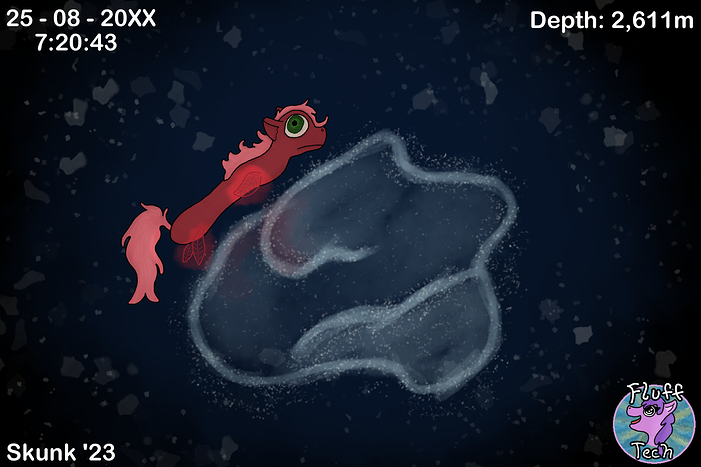Click here for appropriate deep sea music.
August 26, 20XX
Deep Sea Fluffy Expedition Report
Fluff Tech
On August 25, 20XX, Fluff Tech began its first expedition in the Atlantic Ocean near the coast of Mauritania, Africa to determine if the invasive bio-toy species (fluffies) have diversified into the deep sea. A sub-species of fluffies - sea fluffies - are common in warmer, shallower waters, and appeared within an alarming timeframe of the original bio-toy specimens being released from the now-defunct Hasbio facility by members of the radical group PETA. With evidence of their rapid evolution, it begged the question of how fluffies would fare under the heavily pressurized and dark deep sea.
Fluff Tech’s first remotely operated vehicle (ROV), nicknamed “The Delver”, made its decent at approximately 6:30pm. Within approximately 45 minutes, at a depth of 2,611 meters, it spotted what the team both hoped and dreaded to see – a creature strongly resembling a fluffy. It is either blind luck that a creature was found so quickly, or that they have already infested the depths.
This creature – what will now be called Specimen 1 – has the species identifiers of a mane and tail, and the general head shape of a standard fluffy. However, the body is elongated, most likely to accommodate for the increase in water pressure.
The eyes are larger in size and take up the majority of the skull space. This suggests that deep sea fluffies are still reliant on their sight within the pitch dark.
The fins are small, transparent, and bioluminescent. This contrasts with sea fluffies on the surface, who have larger, opaque fins, along with a forked tail for better propulsion. The reasons for the re-evolution of haired tails are a mystery for now.
The shrinkage of the fins may indicate that deep sea fluffies are at the mercy of the water currents and are only used as a balancing measure. Further observations are needed.
Specimen 1’s bioluminescence was constant and devoid of any patterns or flashing. This, combined with its large eyes, suggests that deep sea fluffies are reliant on their bioluminescence to see their surroundings, and perhaps other deep sea fluffies within its vicinity.
It is not surprising that Specimen 1 is a red colouration, as red is practically invisible within the deep sea. Land fluffies who boast red fluff are predisposed to become arrogant and intolerable due to the favour they receive from their parents during foalhood - particularly from the mother - which creates a permanent state of near-narcissism in adulthood (Smarty Syndrome). Whether red deep sea fluffies are at a greater risk of Smarty Syndrome due to their natural invisibility to predators remains to be seen, and further observations are needed to confirm or deny this theory.
It is curious that Specimen 1 is alone, as standard sea fluffies, along with their land ancestors, prefer to create herds for safety in numbers. The reason for this isolation is unknown, but it is common for other deep-sea creatures to be alone, as the deep sea is vast and contains limited resources within the water column. More study is needed.
Specimen 1 was found near a sphere of mucus, suggesting it was the one that created it. How it was done is a mystery for now. This “snot palace” has been observed within other deep-sea denizens as a means to catch the falling detritus of dead sea creatures and their waste products (marine snow) for sustenance. It is unclear what the complete diet of deep-sea fluffies is, but it appears that their main staple is marine snow.
As for behaviour, when Specimen 1 was exposed to the light from The Delver, it froze. This could be due to its eyes being overwhelmed by the light and becoming blind, but the lack of any strong reactions is uncharacteristic of a typical fluffy of any sub-species but is common among other deep-sea specimens recorded by other ROV’s.
After a fair amount of observation, the footage was deemed sufficient for study and The Delver used its vacuum nozzle to collect Specimen 1 within the specimen chamber at the front of the ROV. However, upon resurfacing, Specimen 1’s body could not handle the rapid depressurization and exploded within the specimen chamber. What remains of Specimen 1 is being studied by Fluff Tech scientists aboard their ship, The Fluffspedition.

